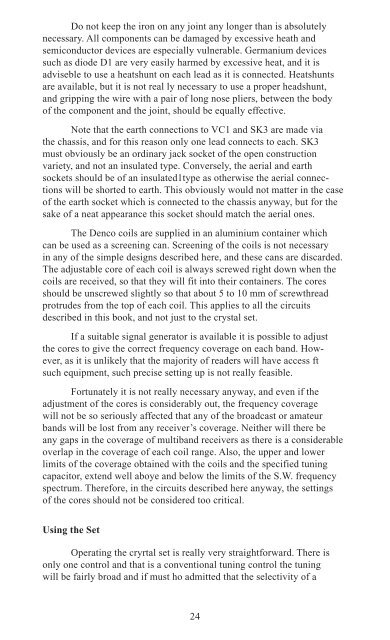Solid State Shortwave Receivers For Beginners - The Listeners Guide
Solid State Shortwave Receivers For Beginners - The Listeners Guide
Solid State Shortwave Receivers For Beginners - The Listeners Guide
Create successful ePaper yourself
Turn your PDF publications into a flip-book with our unique Google optimized e-Paper software.
Do not keep the iron on any joint any longer than is absolutely<br />
necessary. All components can be damaged by excessive heath and<br />
semiconductor devices are especially vulnerable. Germanium devices<br />
such as diode D1 are very easily harmed by excessive heat, and it is<br />
adviseble to use a heatshunt on each lead as it is connected. Heatshunts<br />
are available, but it is not real ly necessary to use a proper headshunt,<br />
and gripping the wire with a pair of long nose pliers, between the body<br />
of the component and the joint, should be equally effective.<br />
Note that the earth connections to VC1 and SK3 are made via<br />
the chassis, and for this reason only one lead connects to each. SK3<br />
must obviously be an ordinary jack socket of the open construction<br />
variety, and not an insulated type. Conversely, the aerial and earth<br />
sockets should be of an insulated1type as otherwise the aerial connections<br />
will be shorted to earth. This obviously would not matter in the case<br />
of the earth socket which is connected to the chassis anyway, but for the<br />
sake of a neat appearance this socket should match the aerial ones.<br />
<strong>The</strong> Denco coils are supplied in an aluminium container which<br />
can be used as a screening can. Screening of the coils is not necessary<br />
in any of the simple designs described here, and these cans are discarded.<br />
<strong>The</strong> adjustable core of each coil is always screwed right down when the<br />
coils are received, so that they will fit into their containers. <strong>The</strong> cores<br />
should be unscrewed slightly so that about 5 to 10 mm of screwthread<br />
protrudes from the top of each coil. This applies to all the circuits<br />
described in this book, and not just to the crystal set.<br />
If a suitable signal generator is available it is possible to adjust<br />
the cores to give the correct frequency coverage on each band. However,<br />
as it is unlikely that the majority of readers will have access ft<br />
such equipment, such precise setting up is not really feasible.<br />
<strong>For</strong>tunately it is not really necessary anyway, and even if the<br />
adjustment of the cores is considerably out, the frequency coverage<br />
will not be so seriously affected that any of the broadcast or amateur<br />
bands will be lost from any receiver’s coverage. Neither will there be<br />
any gaps in the coverage of multiband receivers as there is a considerable<br />
overlap in the coverage of each coil range. Also, the upper and lower<br />
limits of the coverage obtained with the coils and the specified tuning<br />
capacitor, extend well aboye and below the limits of the S.W. frequency<br />
spectrum. <strong>The</strong>refore, in the circuits described here anyway, the settings<br />
of the cores should not be considered too critical.<br />
Using the Set<br />
Operating the cryrtal set is really very straightforward. <strong>The</strong>re is<br />
only one control and that is a conventional tuning control the tuning<br />
will be fairly broad and if must ho admitted that the selectivity of a<br />
24

















